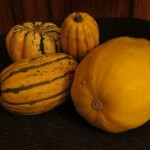 It’s the harvest season, and one group of fall favorites is the squash or gourd family. In addition to tasting great, they are usually low in carbohydrate calories and chock-full of nutrients- particularly fiber, vitamins A and C, and other carotenoids (colorful micronutrients essential to optimum health). Included are some examples of autumn squashes that are prepared with other foods as well as their nutrient content. Some are even edible with the peel left on, and you can stuff this type of squash with ingredients and eat it like you’re holding a sandwich.
It’s the harvest season, and one group of fall favorites is the squash or gourd family. In addition to tasting great, they are usually low in carbohydrate calories and chock-full of nutrients- particularly fiber, vitamins A and C, and other carotenoids (colorful micronutrients essential to optimum health). Included are some examples of autumn squashes that are prepared with other foods as well as their nutrient content. Some are even edible with the peel left on, and you can stuff this type of squash with ingredients and eat it like you’re holding a sandwich.
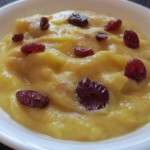 To roast, or cook squash in the oven, usually 45 minutes at 350-375 degrees works well. This is the case when either keeping it in tact or cooking it in order to mash it up. Begin by slicing the squash in half. Scoop out any seeds and discard or save for another time. For butternut squash with its hard, inedible peel, you can purchase it pre-cut at most finer grocery stores. It saves your time and fingers. When pre-cut, it will not take quite as long to cook in the oven if you want it still firm but slightly soft- 30-35 minutes. We often see butternut squash soup during autumn, but why not try acorn squash soup? It does not share the same degree of sweetness and nuttiness of the butternut squash, and is slightly acidic. My version of acorn squash soup plays on this and makes for a hearty entrée.
To roast, or cook squash in the oven, usually 45 minutes at 350-375 degrees works well. This is the case when either keeping it in tact or cooking it in order to mash it up. Begin by slicing the squash in half. Scoop out any seeds and discard or save for another time. For butternut squash with its hard, inedible peel, you can purchase it pre-cut at most finer grocery stores. It saves your time and fingers. When pre-cut, it will not take quite as long to cook in the oven if you want it still firm but slightly soft- 30-35 minutes. We often see butternut squash soup during autumn, but why not try acorn squash soup? It does not share the same degree of sweetness and nuttiness of the butternut squash, and is slightly acidic. My version of acorn squash soup plays on this and makes for a hearty entrée.
With the acorn squash sliced in half, place garlic and shallots on the pan in the oven for 50 minutes at 375. Add to a blender or food processor. Instead of adding any cream, use Greek or European yogurt for more protein and to make a hearty meal out of the soup. You can add chicken or bouillon broth, but I did not in this case because I wanted a thick consistency suitable for an entrée. Place on a stovetop for a few minutes at medium heat until warm. Add white pepper, black pepper, and salt to taste. Garnish with dried cranberries, as the tartness and sweetness compliment the acidic nature of the acorn squash. This bowl of soup gives you 34g of carbs and 15g of protein with the European yogurt version. The Greek yogurt version gives you 26g of carbs and 24g of protein- a better nutritional balance, but also thicker.
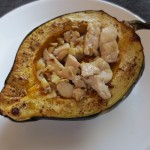 You can use half of an acorn squash as an edible dish with chicken, garlic, and shallots as I did in the next example. A great ratio of carbs to protein is 30g/30g. This is the case as 4oz of chicken is 23-26g of protein. I sautéed garlic and shallots with 5oz of chopped boneless skinless chicken breast before placing it all in the squash.
You can use half of an acorn squash as an edible dish with chicken, garlic, and shallots as I did in the next example. A great ratio of carbs to protein is 30g/30g. This is the case as 4oz of chicken is 23-26g of protein. I sautéed garlic and shallots with 5oz of chopped boneless skinless chicken breast before placing it all in the squash.
 Carnival squash looks like an off-white acorn squash with green and orange ridges between its ribs. It tastes sweeter and nuttier, like a cross between butternut squash and sweet potato. Like the previous example, I filled roasted halves but with pecans and dried cranberries. The flavors of these two additions wonderfully compliment the taste of carnival squash. I also grated a bit of fresh ginger over the meat of the squash after I seasoned with salt, white pepper, and cinnamon.
Carnival squash looks like an off-white acorn squash with green and orange ridges between its ribs. It tastes sweeter and nuttier, like a cross between butternut squash and sweet potato. Like the previous example, I filled roasted halves but with pecans and dried cranberries. The flavors of these two additions wonderfully compliment the taste of carnival squash. I also grated a bit of fresh ginger over the meat of the squash after I seasoned with salt, white pepper, and cinnamon. 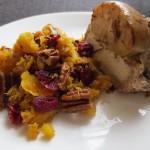 The same ingredients are shown in as a side dish in mashed form next to a serving of pork loin. Pork loin is very lean and readily accepts a myriad of flavor combinations. In this case apples and rosemary were used. These portions of carnival squash with the dried cranberries and pecans give you 29g carbs- most are from the cranberries as the carnival squash only has 6 g of non-fiber starch carbs! The pecans also give you 3g of fiber and 19g of fat- the majority from unsaturated fat that we need. The pork loin is 5oz for 30g of protein. The two apple slices in the pork give you just 5.5g of carbs, including 1g of fiber.
The same ingredients are shown in as a side dish in mashed form next to a serving of pork loin. Pork loin is very lean and readily accepts a myriad of flavor combinations. In this case apples and rosemary were used. These portions of carnival squash with the dried cranberries and pecans give you 29g carbs- most are from the cranberries as the carnival squash only has 6 g of non-fiber starch carbs! The pecans also give you 3g of fiber and 19g of fat- the majority from unsaturated fat that we need. The pork loin is 5oz for 30g of protein. The two apple slices in the pork give you just 5.5g of carbs, including 1g of fiber.
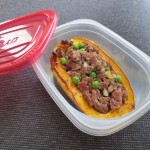 Delicata squash has the same colors as and similar taste to carnival squash. In these examples I used delicata as a side dish or as another delivery vehicle for substantial ingredients. I added ground Bison with sautéed shallots and garlic, and green peas. I seasoned both squash and meat with salt, pepper, and cinnamon. If you haven’t tried it, cinnamon makes a great enhancement to meat and chicken. This meal gives you an unbelievably low 16g of carbs and 6 of those grams are fiber. I also used 5oz of meat for 30g of protein. This example also makes an easy on-the-go meal, as all you have to do is put one of the leftover halves in a Tupperware container and take it to work. This is a simple way around the obstacle of eating on the run. The next example allows you to do the same thing with leftovers.
Delicata squash has the same colors as and similar taste to carnival squash. In these examples I used delicata as a side dish or as another delivery vehicle for substantial ingredients. I added ground Bison with sautéed shallots and garlic, and green peas. I seasoned both squash and meat with salt, pepper, and cinnamon. If you haven’t tried it, cinnamon makes a great enhancement to meat and chicken. This meal gives you an unbelievably low 16g of carbs and 6 of those grams are fiber. I also used 5oz of meat for 30g of protein. This example also makes an easy on-the-go meal, as all you have to do is put one of the leftover halves in a Tupperware container and take it to work. This is a simple way around the obstacle of eating on the run. The next example allows you to do the same thing with leftovers.
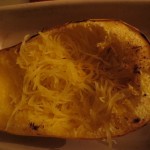 Spaghetti squash is so named because when it is cooked, its meat is pulled out in stringy bundles. Some people recommend baking squashes face down in the oven. With spaghetti squash, the steaming effect results in too watery of a consistency if you are looking to enjoy it in lieu of pasta, as shown here. Face up for 45 minutes at 375 is just fine.
Spaghetti squash is so named because when it is cooked, its meat is pulled out in stringy bundles. Some people recommend baking squashes face down in the oven. With spaghetti squash, the steaming effect results in too watery of a consistency if you are looking to enjoy it in lieu of pasta, as shown here. Face up for 45 minutes at 375 is just fine.
 Two examples are shown- the first is a Gorgonzola chicken dish with roasted red peppers, sun- dried tomatoes, cremini mushrooms, and green peas. 31g of protein and 40.5g carbs, with 11 of those grams from fiber.
Two examples are shown- the first is a Gorgonzola chicken dish with roasted red peppers, sun- dried tomatoes, cremini mushrooms, and green peas. 31g of protein and 40.5g carbs, with 11 of those grams from fiber. 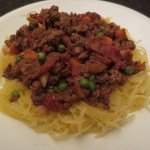 The second is a bison Bolognese with cinnamon and green peas. 30g of protein with 33g of carbs, and 10 of those carb grams are fiber. The flavors were even better the next day!
The second is a bison Bolognese with cinnamon and green peas. 30g of protein with 33g of carbs, and 10 of those carb grams are fiber. The flavors were even better the next day!
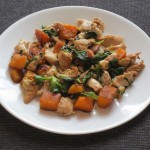 Examples of butternut squash are shown as an integral part of the entrée. One is a chicken breast dish with butternut squash cubes griddled in the pan. In this case use medium heat for a half hour, making sure to flip them once halfway. In the last ten minutes the chicken was added, and then the spinach in the last five minutes before the heat was cut off. Season with salt, black pepper, and white pepper. You get 33.5g protein, 22.5g carbs, and 5.5g fiber. Only 3.5g of fat.
Examples of butternut squash are shown as an integral part of the entrée. One is a chicken breast dish with butternut squash cubes griddled in the pan. In this case use medium heat for a half hour, making sure to flip them once halfway. In the last ten minutes the chicken was added, and then the spinach in the last five minutes before the heat was cut off. Season with salt, black pepper, and white pepper. You get 33.5g protein, 22.5g carbs, and 5.5g fiber. Only 3.5g of fat.
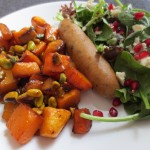 The next butternut squash dish is just like we have as a side dish at our seminar. Cubes are roasted in the oven for a half hour, then pistachios are added for the last seven minutes. Once out of the oven, a conservative spoon of honey is drizzled over the portion. You get only 19g of carbs and five of those are fiber. The chicken sausage supplies 18g of protein and only 6g of fat. A side salad of baby spinach, gorgonzola, and pomegranate seeds give you 8g of protein and 4g of carbs, half of those carbs being fiber.
The next butternut squash dish is just like we have as a side dish at our seminar. Cubes are roasted in the oven for a half hour, then pistachios are added for the last seven minutes. Once out of the oven, a conservative spoon of honey is drizzled over the portion. You get only 19g of carbs and five of those are fiber. The chicken sausage supplies 18g of protein and only 6g of fat. A side salad of baby spinach, gorgonzola, and pomegranate seeds give you 8g of protein and 4g of carbs, half of those carbs being fiber.
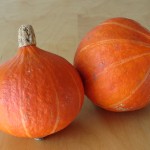 The final example is a red kuri squash, sometimes called a red kuri buttercup, baby red Hubbard or orange Hokkaido. It looks like a mini pumpkin but without the ribbed surface. It is higher in starch than the aforementioned squashes but still relatively low- about 36g of carbohydrates in a whole red kuri squash. Figure half of one at the most per meal, and you are in a very calorie-safe range.
The final example is a red kuri squash, sometimes called a red kuri buttercup, baby red Hubbard or orange Hokkaido. It looks like a mini pumpkin but without the ribbed surface. It is higher in starch than the aforementioned squashes but still relatively low- about 36g of carbohydrates in a whole red kuri squash. Figure half of one at the most per meal, and you are in a very calorie-safe range.
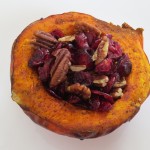 This squash has a more mellow, almost chestnut flavor and subtle sweetness- almost like a nutmeg. Cinnamon, allspice, and white pepper make complimentary seasonings. The first example is just like we saw for carnival squash- dried cranberries and pecans. Total carbohydrate load comes to 40g, but 7g are fiber.
This squash has a more mellow, almost chestnut flavor and subtle sweetness- almost like a nutmeg. Cinnamon, allspice, and white pepper make complimentary seasonings. The first example is just like we saw for carnival squash- dried cranberries and pecans. Total carbohydrate load comes to 40g, but 7g are fiber. 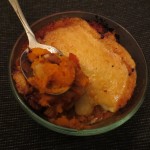 The second example is a decadent gratinée that is a full entrée including ample protein (27g), 21g of carbs (six of those fiber) and 40g of fat. Eat lean the rest of the day. Half of the fat content is from walnuts- healthy omega vegetable fats that are essential to human health. They help you release your own bodyfat and burn it as energy, as well as repackage and remove LDL cholesterol and contribute to increasing HDL cholesterol (general desirable). The other fat is from the Gruyère cheese that smothers the top. A hint of nutmeg was added with salt, white and black pepper into the squash mash before the walnuts and finally gruyère was layered on top.
The second example is a decadent gratinée that is a full entrée including ample protein (27g), 21g of carbs (six of those fiber) and 40g of fat. Eat lean the rest of the day. Half of the fat content is from walnuts- healthy omega vegetable fats that are essential to human health. They help you release your own bodyfat and burn it as energy, as well as repackage and remove LDL cholesterol and contribute to increasing HDL cholesterol (general desirable). The other fat is from the Gruyère cheese that smothers the top. A hint of nutmeg was added with salt, white and black pepper into the squash mash before the walnuts and finally gruyère was layered on top.
I hope you enjoy trying different ways to cook, serve and eat these wonderful squashes. These meals are all low-glycemic, meaning they minimally impact your blood sugar. They stay with you for hours as the carbohydrate that is present breaks down slowly and the rich micronutrient content helps your body become a metabolic furnace while making you feel better and more energetic at the same time. More energy, better focus, and fast-food temptations removed! If you would like some recipes of specific examples above, email me at drew@lwlcoaching.com. Bon appétit!
